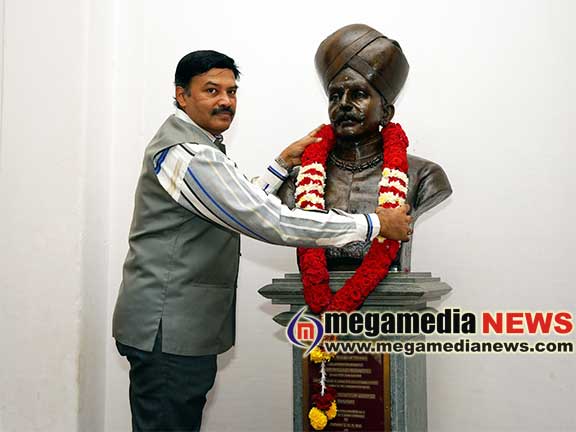IISc remembers NalwadiKrishnaraja Wadiyar, a former Maharaja of Mysore, on his 137th birth anniversary
9:08 PM, Friday, June 4th, 2021 Mysuru: Capt. Sridhar Warrier, the Registrar of the Indian Institute of Science (IISc), paid his respects to Wadiyar on the occasion of the anniversary, by garlanding his statue at the Main Building of the Institute.
Mysuru: Capt. Sridhar Warrier, the Registrar of the Indian Institute of Science (IISc), paid his respects to Wadiyar on the occasion of the anniversary, by garlanding his statue at the Main Building of the Institute.
Wadiyar born on 4 June 1884, NalwadiKrishnaraja Wadiyar became the Maharaja of Mysore Kingdom in 1894 after his father Chamarajendra Wadiyar died at a young age. But he took over the reins of power only in 1902, when he reached the age of majority. Between 1894 and 1902, the Mysore Kingdom was governed by his mother, Maharani Kempananjammani Vani VilasaSannidhana, on behalf of her eldest son.
It was during the reign of the Maharani that the Mysore Kingdom offered land and financial assistance to JN Tata’s ambitious project of setting up a research university in India. Her decision, in her son’s name, was communicated by the Dewan of Mysore, Seshadri Iyer, to the Provisional Committee responsible for the setting up the yet-to-be-named research university.
The establishment of IISc was delayed for a few more years. There were several reasons for the delay, including the untimely death of JN Tata in 1904, but finally in 1907, Wadiyar handed over 371 acres and 16 guntas of land in the heart of Bangalore for the project through Dewan VP Madhava Rao. Mysore also gave Rs 5 lakh towards capital expenditure and promised an annual contribution of Rs. 50,000 for IISc.
Under Wadiyar, Mysore’s commitment to the growth of IISc continued. In 1912, the engineer M Visvesvaraya became the Dewan and also became part of IISc’s Governing Council the following year. He pushed for a significant role for IISc in helping Mysore (and India) become more industrialised. Several new industries were set up with the help of IISc’s assistance: an acetone factory in Nasik, a thymol factory in Hyderabad (Sindh), a factory to make straw boards from bamboo in Bangalore, a soap factory in Bangalore and sandalwood oil factories in Bangalore and Mysore city. The Institute also provided technical help to Hyderabad State for producing alcohol from mahua flowers and to the Mysore Spinning and Weaving Mills in Bangalore to make a durable textile dye using sappan wood (wood from a local leguminous tree) and catechu (an acacia extract).
The most successful of the industries were the sandalwood oil factories and the soap factory, which ensured that the wood and its products became synonymous with the erstwhile state of Mysore, and now the state of Karnataka.
On 1 February 1911, a few months before the Institute opened its doors to its first batch of students, Wadiyar came to IISc to lay the foundation stone of the Main Building. Speaking on the occasion, he praised the generosity of his mother for providing land and money to help make Tata’s dream come true. He also used the opportunity to urge the Institute not to restrict scientific research to students of “independent means” and consider providing scholarships to those “who have no capital at their backs.” His plea was taken seriously by the Council. Soon, IISc announced that it would be offering 11 scholarships to economically disadvantaged students.
A few years later, on 10 March 1922, it was again Wadiyar who was invited to the Institute to unveil the monument dedicated to its founder, JN Tata.
Wadiyar died in 1940, but not before helping nurture India’s premier research institution, a legacy that his successor Jayachamaraja Wadiyar carried forward.
Simillar Posts
Warning: count(): Parameter must be an array or an object that implements Countable in /home/megamcaq/public_html/wp-content/plugins/post-plugin-library/common_functions.php on line 357
- None Found
Leave a Reply
© Copyright 2008 www.megamedianews.com All Rights Reserved. Privacy Policy








 Posted in
Posted in  Tags:
Tags: 






